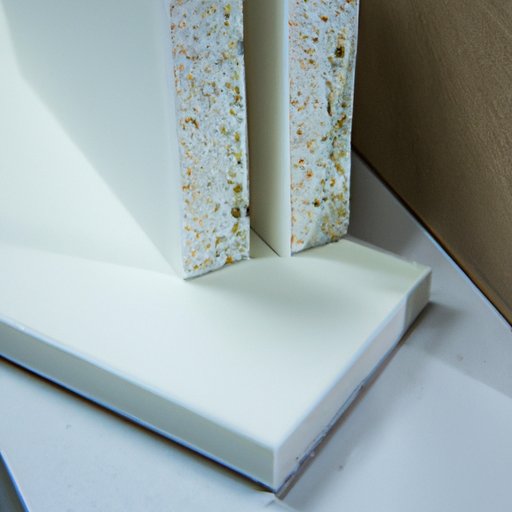Introduction
Drywall is a key component of modern home construction, as it provides a lightweight and cost-effective way to build walls. But when was drywall invented? This article looks at the history of drywall, exploring when it was first invented and how it has evolved over time.

Overview of the History of Drywall
Drywall, also known as sheetrock or gypsum board, is a type of wall panel made from gypsum plaster and encased in paper or fiberglass. It is used to construct interior walls and ceilings, and is one of the most popular building materials in the world. The use of drywall dates back to the early 20th century, when it was developed as an alternative to traditional lath and plaster construction.
Exploring When Drywall Was First Invented
The earliest forms of wall construction were made from wood, stone, or earth. However, these materials were often difficult to use and prone to decay. By the late 19th century, lath and plaster had become the standard for wall construction. This method involved attaching thin wooden strips (or laths) to the wall studs, then covering them with a layer of wet plaster. While this method was more durable than earlier methods, it was also labor-intensive and time-consuming.
In 1916, the U.S. Gypsum Company introduced the first product that would later be known as drywall. It was called Sheetrock, and it was created by combining gypsum plaster with several layers of heavy paper. Sheetrock was easier to install than traditional lath and plaster walls, and it quickly became a popular choice for home builders.
Examining the Evolution of Drywall
Since its introduction, drywall has undergone several changes and improvements. Early versions of drywall were vulnerable to moisture damage, so manufacturers began adding waterproofing agents and protective coatings. As technology advanced, new materials such as fiberglass reinforced panels and fire-resistant boards were developed. These changes allowed drywall to be used in a greater range of applications, including bathrooms, kitchens, and other areas where moisture and fire resistance are important.
The development of drywall has also had a major impact on home construction. According to a study published in the journal Building and Environment, drywall “has drastically increased the speed and efficiency of building construction, reduced labor costs, and enabled the adoption of new construction techniques.” This has led to faster, cheaper, and safer building projects.

A Timeline of Drywall Innovations
Since its invention, drywall has seen many advances in technology and materials. Here is a timeline of some of the major developments in drywall history:
- 1916: The U.S. Gypsum Company introduces Sheetrock, the first product that would later be known as drywall.
- 1950s: Waterproofing agents and protective coatings are added to drywall to make it more resistant to moisture.
- 1960s: Fiberglass reinforced drywall panels are introduced, allowing for improved strength and durability.
- 1970s: Fire-resistant drywall boards become available, enabling drywall to be used in areas where fire safety is a concern.
- 1980s: Specialty drywall products, such as soundproofing, mold-resistant, and impact-resistant boards, are developed.

How Drywall Changed Home Construction
The introduction of drywall revolutionized home construction. Its lightweight design made it easier to transport and install than traditional lath and plaster walls, and its affordability made it accessible to a wider range of people. According to the National Association of Home Builders, “drywall greatly simplified the process of building walls, making it possible to construct a basic house in just a few days.”
Drywall also provided a number of benefits, such as improved insulation and soundproofing. It can be painted or wallpapered to match any décor, and it is easy to repair if damaged. These features have made drywall a popular choice for homebuilders and homeowners alike.
Who Invented Drywall?
The invention of drywall is credited to two men: George A. Faulds and Norman B. Reis. Faulds was an engineer at the U.S. Gypsum Company who developed the first drywall panel in 1916. Reis was a chemist who helped refine the process for making drywall. Together, they pioneered the modern drywall industry.
Faulds and Reis’ contributions to the industry have been recognized by the Wall and Ceiling Alliance, which inducted them into the Drywall Hall of Fame in 1997. Since then, their legacy has continued to inspire innovators in the drywall industry.
Conclusion
Drywall is one of the most important inventions in home construction. It was first invented in 1916 by George A. Faulds and Norman B. Reis, and since then it has undergone many changes and improvements. Today, drywall is used in virtually all types of residential and commercial buildings, and it continues to be a popular choice for homebuilders and homeowners.
This article explored the history of drywall, from its invention to the present day. It examined the timeline of drywall innovations, how it changed home construction, and who invented it. Understanding the history of drywall is essential for anyone looking to build a home or remodel an existing one.
(Note: Is this article not meeting your expectations? Do you have knowledge or insights to share? Unlock new opportunities and expand your reach by joining our authors team. Click Registration to join us and share your expertise with our readers.)
